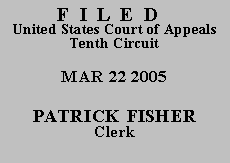

| UNITED STATES OF AMERICA, |
|
| v. | |
| RONNIE DARNELL MILLER, |
(D.C. Nos. 91-CR-51 and 04-CV-954-R) |
To obtain a certificate of appealability, Mr. Miller must demonstrate "that jurists of reason would find it debatable whether the petition states a valid claim of the denial of a constitutional right, and that jurists of reason would find it debatable whether the district court was correct in its procedural ruling." Slack v. McDaniel, 529 U.S. 473, 478 (2000).
I. BACKGROUND
Prisoners whose convictions became final on or before April 24, 1996, the effective date of the Antiterrorism and Effective Death Penalty Act ("AEDPA") became effective, must file motions pursuant to 28 U.S.C. § 2255 on or before April 24, 1997. See United States v. Hurst, 322 F.3d 1256, 1261 (10th Cir. 2003). On July 30, 1991, Mr. Miller was convicted for possession with intent to distribute cocaine base in violation of 21 U.S.C. § 841(a)(1) and conspiracy to distribute cocaine and cocaine base in violation of 21 U.S.C. § 846. This court affirmed his conviction on March 1, 1993.
Because Mr. Miller did not elect to seek certiorari in the United States Supreme Court, his conviction and sentence became final ninety days after our March 1, 1993 opinion, or on May 30, 1993. See Sup. Ct. R. 13(1) (establishing a ninety-day window during which a defendant may seek certiorari from a judgment of a federal court of appeals); United States v. Burch, 202 F.3d 1274, 1276 (10th Cir. 2000) (holding that "for purposes of determining when the limitations period in 28 U.S.C. § 2255(1) begins to run if a defendant does not petition the United States Supreme Court for a writ of certiorari after h[is] direct appeal, h[is] judgment of conviction is final after the time for seeking certiorari review has expired").
Therefore, Mr. Miller had until April 24, 1997 to file his § 2255 motion, unless, as the district court noted, "the statute of limitations did not begin to run until a later date as set forth in 28 U.S.C. § 2255(2), (3) or (4)" or if the AEDPA statute of limitations should be equitably tolled. Rec. doc. 341 at 2 (Dist. Ct. Order, filed Sept. 27, 2004). Section 2255 provides that
A 1-year period of limitation shall apply to a motion under this section. The limitation period shall run from the latest of--
(1) the date on which the judgment of conviction becomes final;
(2) the date on which the impediment to making a motion created by governmental action in violation of the Constitution or laws of the United States is removed, if the movant was prevented from making a motion by such governmental action;
(3) the date on which the right asserted was initially recognized by the Supreme Court, if that right has been newly recognized by the Supreme Court and made retroactively applicable to cases on collateral review; or
(4) the date on which the facts supporting the claim or claims presented could have been discovered through the exercise of due diligence.28 U.S.C. § 2255(2)-(4).
II. DISCUSSION
Mr. Miller filed his § 2255 motion on August 2, 2004. The district court denied his § 2255 motion as untimely, and noted that Mr. Miller does not argue that the statute of limitations should be equitably tolled. Rather, Mr. Miller argued before the district court, and also argues before us, that the application of the AEDPA statute of limitations to an individual like himself is impermissible retroactive and precluded by the United States Supreme Court's decision in Landgraf v. USI Film Products, 511 U.S. 244 (1994).
In United States v. Simmonds, 111 F.3d 737 (10th Cir.1997), overruled in part by Hurst, 332 F.3d 1256 n.4 (en banc footnote), we concluded application of the one-year limitations period to bar § 2255 actions by prisoners whose convictions became final before the AEDPA took effect would be impermissibly retroactive. To avoid impermissible retroactivity, such prisoners must be given a reasonable amount of time after the effective date of the statute to bring their actions. We further determined that the statutory one-year period was a reasonable time, thus requiring prisoners whose convictions became final on or before April 24, 1996 to file their § 2255 motions before April 24, 1997. Hurst, 332 at 1261; Simmonds, 111 F.3d at 746.
III. CONCLUSION
Accordingly, for substantially the same reasons as the district court, we reject Mr. Miller's suggestion that he is not bound by AEDPA's statute of limitations. We conclude that the district court correctly dismissed Mr. Miller's § 2255 motion as untimely. We determine that Mr. Miller has failed to raise a debatable issue, and therefore we DENY his request for a COA, and DISMISS the appeal.
Entered for the Court,
Circuit Judge